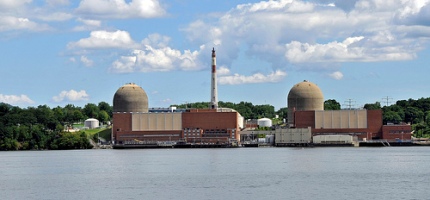Are Nuclear Evacuation Plans a Fantasy? Asks NYT Columnist
03/23/2011 - New York Times Columnist Peter C. Applebome wonders if we're all justkidding ourselves about evacuation plans if Japan's nuclear crisis occurred here in the United States. To make his point, he asks what would happen if people around New York's Indian Point nuclear power plant took the U.S. government's advice to American expats and travelers to stay at least 50 miles away from Japan's Fukushima Daiichi Nuclear Power Station.
In the case of a comparable disaster here, this is what a 50-mile circle around the Indian Point nuclear plant on the Hudson River in Westchester County would look like: past Kingston in Ulster County to the north; past Bayonne and Elizabeth, N.J., to the south; almost to New Haven in the east; and into Pennsylvania to the west. It includes almost all of New York City except for Staten Island; almost all of Nassau County and much of Suffolk; all of Bergen County, N.J.; all of Fairfield, Conn.
Try evacuating that on short — or long — notice.
“Many scholars have already argued that any evacuation plans shouldn’t be called plans, but rather ‘fantasy documents,’ ” Daniel P. Aldrich, a professor of political science at Purdue University and the author of “Site Fights: Divisive Facilities and Civil Society in Japan and the West,” said in an e-mail. They are often bureaucratic documents meant to meet policy requirements, not to work in the real world, he added.
Naturally, Applebome observes, Japan's nuclear crisis has set off concerns about what would happen if Indian Point suffered a meltdown, just 35 miles away from midtown Manhattan and sitting in the middle of a 50-mile radius in which 6 percent of the U.S. population lives, according to New York Gov. Andrew Cuomo. Such population density means "evacuation isn't even a feasible concept," Cuomo said, according to the Associated Press.
Past reviews of emergency planning at the plant and the surrounding areas don't inspire much confidence, Applebome writes. In 2003, a 256-page study(.pdf) commissioned by Gov. George E. Pataki onIndian Point's emergency planning was completed by Witt Associates, a Washington, D.C.-based public safety and crisis management consulting firm.
Applebome reports that the study "concluded that the plans were drafted to comply with regulations rather than to create an effective strategy to protect the population, and that they assumed people would comply with government directives rather than do what seemed to be in their own best interests."
Here's how the report summarized its finding on emergency planning around the Indian Point nuclear power plant.
In our report we discuss significant planning inadequacies, expected parental behavior that would compromise school evacuation, difficulties in communications, outdated vulnerability assessment, the use of outdated technologies, lack of first responder confidence in the plan(s), problems caused by spontaneous evacuation, the nature of the road system, the thin public education effort, and how these issues may impact an effective response in a high population area. None of these problems, when considered in isolation, precludes effective response. When considered together, however, it is our conclusion that the current radiological response system and capabilities are not adequate to overcome their combined weight and protect the people from an unacceptable dose of radiation in the event of a release from Indian Point. We believe this is especially true if the release is faster or larger than the typical exercise scenario.
Last Wednesday, Cuomo called for Indian Pointto be shut downafter the Nuclear Regulatory Commission reported that one of the plant's reactors sits on a fault line and is vulnerable to an earthquake.
Indian Point's owner,Entergy Corp., took out a full-page ad in The New York Times on Monday, assuring the area's residents that the plant can withstand the strongest anticipated earthquake for the area
View Larger Map
